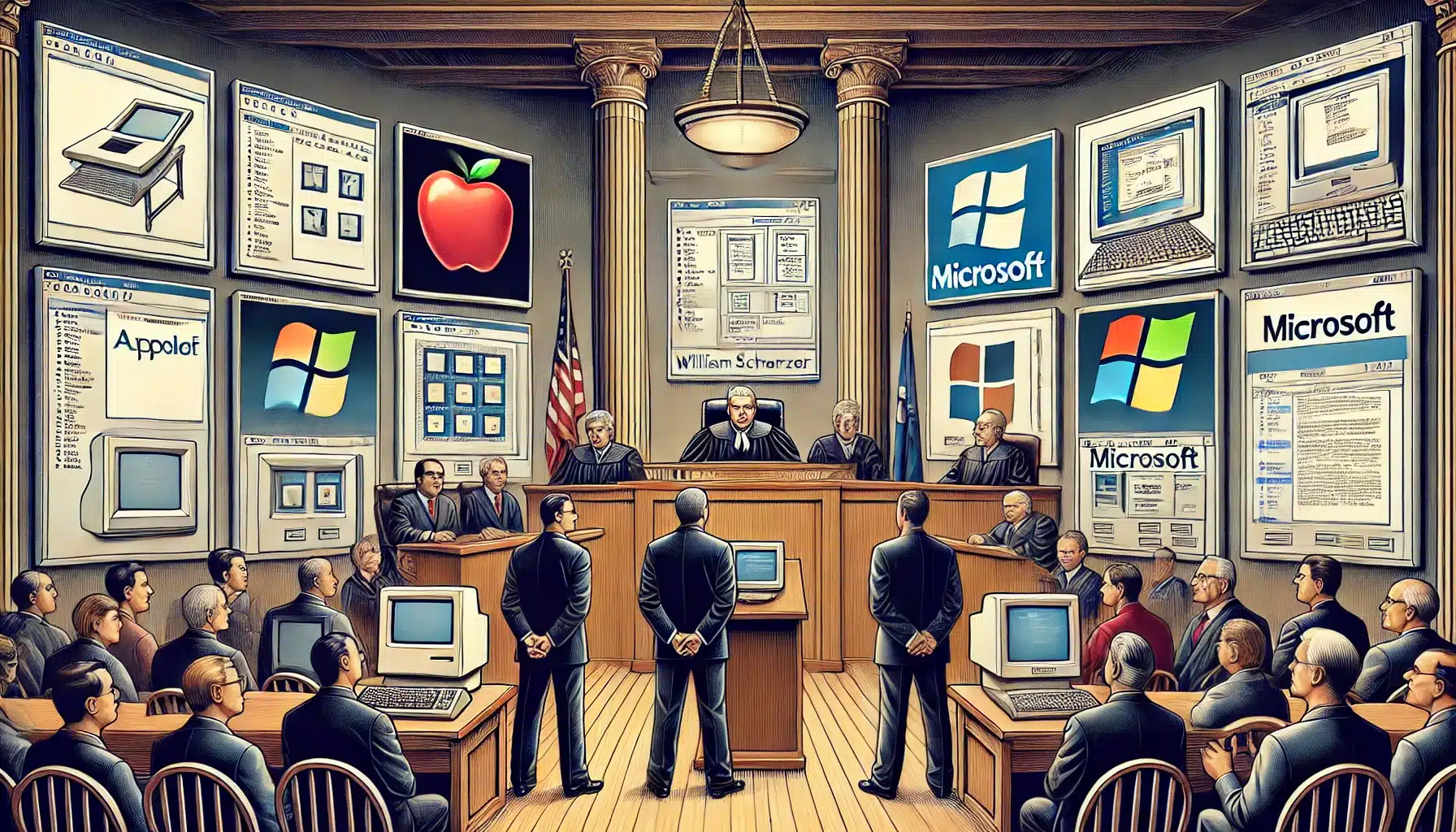In the 1991 case Apple Computer, Inc. v. Microsoft Corporation & Hewlett-Packard Company, Apple sued Microsoft and HP, alleging that their software infringed on Apple’s copyright-protected graphical user interface (GUI) from the Macintosh. The court ruled that while the 1985 Agreement between Apple

“Copyright protection requires minimal originality in the expression of ideas, not novelty, and that a certificate of copyright registration is prima facie evidence of validity, with the burden of proof for challenging this validity falling on the defendant.”
Citation: 759 F. Supp. 1444 (N.D. Cal. 1991)
Date of Judgement: 6th March, 1991
Court: U.S. District Court for the Northern District of California
Bench: William Schwarzer (J)
Facts
- On March 17, 1988, Apple Computer, Inc. (“Apple”) filed a copyright infringement lawsuit against Microsoft Corporation (“Microsoft”) and Hewlett-Packard Company (“HP”), alleging that Microsoft’s Windows operating system and HP’s NewWave application software infringed on Apple’s copyrights related to its innovative Macintosh graphical user interface (GUI).
- This GUI, notable for its intuitive use of windows, icons, and pull-down menus, was a major advancement in user interface design and significantly contributed to Apple’s market success.
- In 1985, Apple and Microsoft had reached a settlement addressing some visual similarities, which included Microsoft’s recognition of the derivative nature of certain visual displays in Windows 1.0, licensing terms for these displays, and specific restrictions on application releases and improvements. Despite this 1985 Agreement, Apple later contended that Microsoft’s Windows 2.03 and HP’s NewWave continued to infringe on its copyrights.
- The litigation thus focused on whether these newer software versions violated the 1985 Agreement and the overall validity of Apple’s copyright claims.
Contentions of the Parties
Apple’s Contentions: Apple argued that the 1985 Agreement did not extend to the visual displays in Microsoft’s Windows 2.03 or HP’s NewWave software. Apple asserted that the agreement was specific to Windows Version 1.0 and did not cover later versions or enhancements. Apple sought to affirm the validity of its copyrights and dismiss the defendants’ claims related to fraud and lack of originality, emphasizing that Microsoft’s and HP’s software infringed upon its protected visual displays.
Microsoft’s Defense: Microsoft contended that seven specific visual displays from Windows 2.03 were licensed under the 1985 Agreement. These displays included overlapping windows in various configurations and visual effects related to window movement and interaction. Microsoft argued that the agreement, which initially covered Windows Version 1.0, also encompassed these elements used in later versions of its software. Microsoft’s defense was based on the assertion that its licenses included the disputed visual displays.
HP’s Defense: HP sought partial summary adjudication, arguing that eleven of the fifty visual displays listed by Apple were licensed under the 1985 Agreement, thereby exempting them from copyright infringement claims. HP also challenged the validity of Apple’s copyrights on grounds of alleged fraud and lack of originality, suggesting that Apple’s GUI was influenced by Xerox’s graphical interfaces and therefore lacked originality.
Decision
Judge Schwarzer’s Findings:
The 1985 Agreement did not fully shield Microsoft from infringement claims but licensed specific visual displays from Windows Version 1.0.
The agreement covered only particular visual displays and not future modifications or enhancements.
The seven visual displays cited by Microsoft (A1, A8, B1, B2, D1, D2, D3) were created by the Macintosh system software and not licensed under the 1985 Agreement.
HP’s Motion Analysis:
The court found that visual displays I3, I5, I12, F18, F19, and G22 were licensed under the 1985 Agreement and thus protected from Apple’s claims.
Displays G19, G10, and G20 were unlicensed, with G19 showing differences in reverse video selection, and G10 and G20 being deemed more about ideas than expression.
Apple’s Motion Analysis:
The court upheld the validity of Apple’s copyrights, dismissing HP’s claims of fraud and lack of originality.
The court determined that borrowing ideas does not invalidate copyright protection and that Apple’s works involved minimal originality.
“The standard of originality required for copyrightability is minimal… To fulfill the originality requirement, a work need only be independently created by the author and embody a very modest amount of intellectual labor; novelty or uniqueness is not essential.
Similarly, although there is evidence that Apple’s designers borrowed ideas from Xerox’s Smalltalk and Star programs, there is no substantiation for the allegation that Apple copied protectible elements of expression from those programs.”
Key legal issues discussed
1. Did the 1985 Agreement license visual displays from newer versions of Windows?
No
The 1985 Agreement did not extend to newer versions or enhancements of Windows. The 1985 Agreement specifically addressed visual displays in Windows Version 1.0 and certain application programs associated with it. The agreement explicitly provided Microsoft with a license for specific visual displays but did not cover future software versions or modifications beyond Windows Version 1.0.
2. Were the seven visual displays cited by Microsoft covered under the 1985 Agreement?
No
The seven visual displays were not covered under the 1985 Agreement as they were generated by the Macintosh system software, not solely by Microsoft’s application programs.
Judge Schwarzer determined that the visual displays in question (A1, A8, B1, B2, D1, D2, D3) were the result of interactions with Macintosh system software rather than Microsoft’s application code alone. The agreement’s licensing was confined to displays created by Microsoft’s application programs.
3. Did Apple’s work lack originality and acquire copyright registration through fraud?
No
HP challenged Apple’s copyrights on grounds of fraud and lack of originality, but these challenges were not substantiated. The court found that HP’s allegations of fraud were unsupported as there was no evidence showing Apple’s intent to deceive the Copyright Office. Apple’s works, while influenced by Xerox, involved original elements beyond the general ideas and were independently created.
4. Does influence from prior works, like Xerox’s programs, negate the originality of Apple’s works?
No
The court emphasized that copyright does not require complete novelty but rather minimal originality and independent creation. This means that a work does not need to be entirely new but must exhibit some unique expression that is created independently by its author. Influence from other works is permissible, and copyright is not invalidated merely because a work is inspired by or resembles another. For a claim of copyright infringement to succeed, it must be proven that the new work is a direct copy of the protected expression of the original, rather than simply sharing similar ideas or themes.


